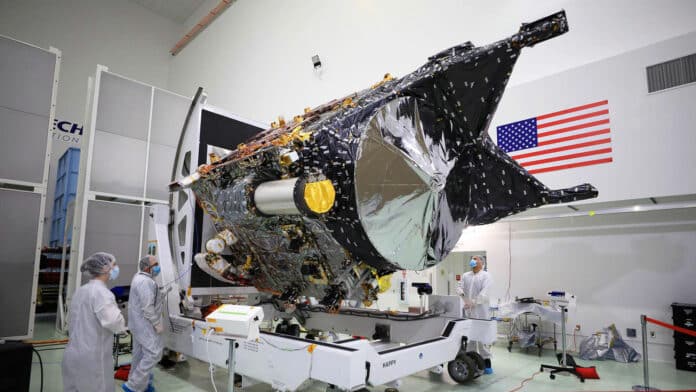NASA’s Deep Space Optical Communications (DSOC) experiment has achieved ‘first light,’ sending data via laser to and from far beyond the Moon for the first time.
It has beamed a near-infrared laser encoded with test data from nearly 10 million miles (16 million kilometers) away – about 40 times farther than the Moon is from Earth – to the Hale Telescope at Caltech’s Palomar Observatory in San Diego County, California. This is the farthest-ever demonstration of optical communications.
The DSOC experiment is part of NASA’s Psyche mission, which was recently launched to study the metal-rich asteroid 16-Psyche. This new system is configured to send high-bandwidth test data to Earth during its two-year technology demonstration as Psyche travels to the main asteroid belt between Mars and Jupiter.
It aims to demonstrate data transmission rates 10 to 100 times greater than the state-of-the-art radio frequency systems used by spacecraft today. Both radio and near-infrared laser communications use electromagnetic waves to transmit data. But near-infrared light packs the data into much tighter waves, which allows ground stations to receive more data. This advancement is expected to benefit future human and robotic exploration missions while supporting higher-resolution science instruments.
“Optical communication is a boon for scientists and researchers who always want more from their space missions, and will enable human exploration of deep space,” said Dr. Jason Mitchell, director of the Advanced Communications and Navigation Technologies Division within NASA’s Space Communications and Navigation (SCaN) program. “More data means more discoveries.”
On November 14th, the tech demo achieved “first light” after its flight laser transceiver, capable of sending and receiving near-infrared signals, locked onto a powerful uplink laser beacon transmitted from the Optical Communications Telescope Laboratory at JPL’s Table Mountain Facility near Wrightwood, California. The uplink beacon allowed the transceiver to aim its downlink laser back to Palomar, which is located 100 miles (or 130 kilometers) south of Table Mountain, while automated systems on the transceiver and ground stations fine-tuned its pointing.
“Achieving first light is one of many critical DSOC milestones in the coming months, paving the way toward higher-data-rate communications capable of sending scientific information, high-definition imagery, and streaming video in support of humanity’s next giant leap: sending humans to Mars,” said Trudy Kortes, director of Technology Demonstrations at NASA Headquarters in Washington.
The experiment also sent test data via both the uplink and downlink lasers, a procedure known as “closing the link.” Although it doesn’t transmit Psyche mission data, the technology demonstration works closely with the Psyche mission-support team to avoid any interference with the spacecraft operations.
Following a successful first light, the DSOC team will now focus on fine-tuning the systems that control the pointing of the downlink laser aboard the transceiver. Once accomplished, the project can then proceed to demonstrate how to maintain high-bandwidth data transmission from the transceiver to Palomar at varying distances from Earth.
This data is transmitted as bits, which are the smallest units of data that a computer can process, and are encoded in the laser’s photons – quantum particles of light. After detecting the photons using a special superconducting high-efficiency detector array, new signal-processing techniques are utilized to extract the data from the single photons that arrive at the Hale Telescope.
While optical communication has been proved in low Earth orbit and out to the Moon, the DSOC project is the first to test it in deep space. Aiming a laser beam over millions of miles requires tremendously precise “pointing,” similar to using a laser pointer to track a moving dime from a mile away.
The demonstration also needs to account for the time it takes for light to travel from the spacecraft to Earth over vast distances. At Psyche’s farthest distance from Earth, DSOC’s near-infrared photons will take approximately 20 minutes to travel back. During the Nov. 14 test, it took about 50 seconds for the photons to travel from Psyche to Earth. In that time, both the spacecraft and planet will have moved, necessitating adjustments to the uplink and downlink lasers to account for the change in location.
“Achieving first light is a tremendous achievement. The ground systems successfully detected the deep space laser photons from DSOC’s flight transceiver aboard Psyche,” said Abi Biswas, project technologist for DSOC at JPL. “And we were also able to send some data, meaning we were able to exchange ‘bits of light’ from and to deep space.”
